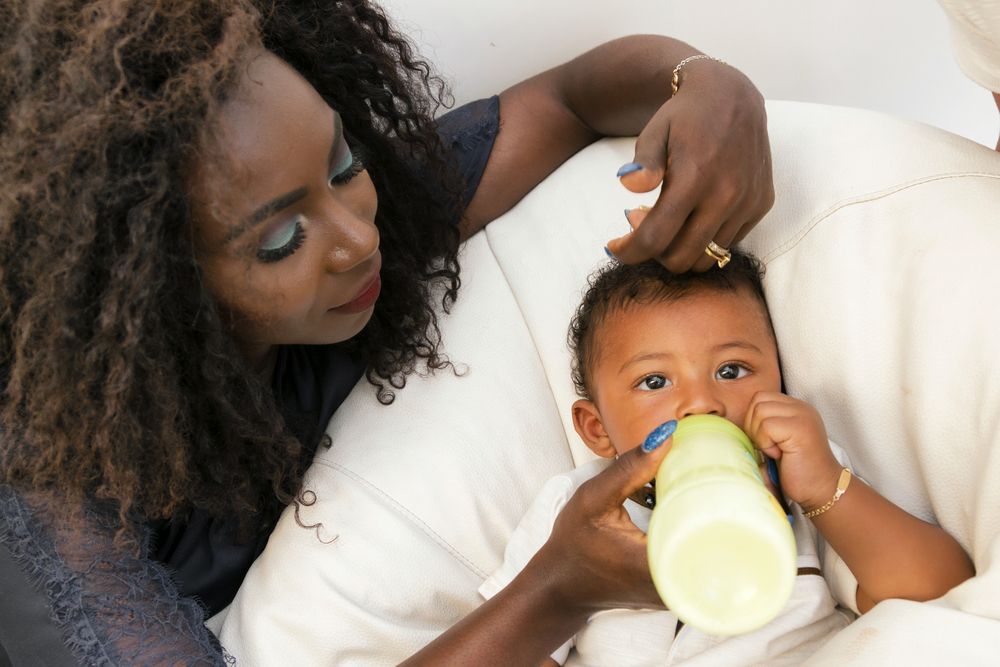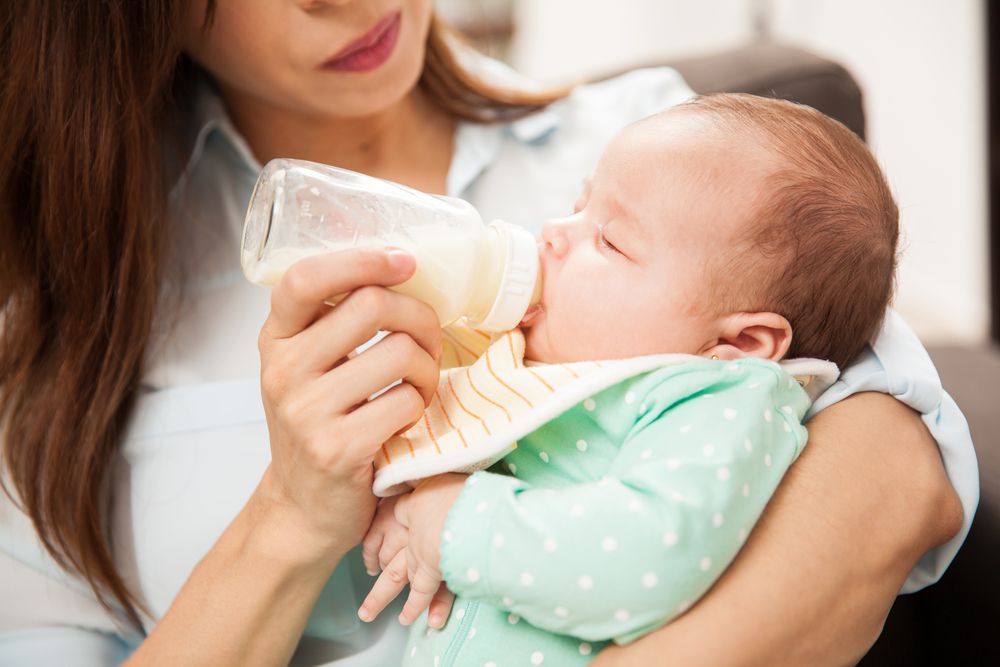Do you need your baby to take a bottle because you’re struggling with low supply, you’re getting ready to go back to work, or you’re planning to be away from your baby for a few hours for a date night or some self-care?
And are you at your wits end and stressed every second you’re away because no matter what you do your breastfed baby won’t take a bottle? Do you feel trapped like you can never leave your baby or worried that your baby isn’t getting enough milk when you’re not with them?
Breastfed babies often refuse the bottle because they prefer nursing. If you’re able to mimic the best parts of breastfeeding and make bottle sessions special for your baby too, you can finally help your breastfed baby to take a bottle.
After experimenting to overcome my baby’s bottle refusal and supporting lots of other families, I’ve put together the 7 most important tips you need to know to help your breastfed baby overcome bottle refusal and actually enjoy bottle feeding sessions too.
Jump To:
🤱 Why do babies often prefer breastfeeding? ⛔ Why is my baby suddenly refusing the bottle? 🍼 How to get your breastfed baby to take a bottle 💭 Final Thoughts
DISCLOSURE: Piece of Cake Parenting is a participant in the Amazon Services LLC Associates Program, an affiliate advertising program. As an Amazon Associate, I earn from qualifying purchases. Read more about these links in my disclaimer policy.
Why Do Babies Often Prefer Breastfeeding?
The most common reason babies prefer breastfeeding is because they feel more connected with you.

Breastfeeding stimulates the release of oxytocin, a hormone that promotes love, nurturing, and a strong emotional bond with your baby.
If that’s not enough of a reason for your baby to love breastfeeding, nursing also stimulates several other senses by allowing your baby to touch your skin, smell your breastmilk, look into your eyes, and promote the bond between the two of you.
Since your baby’s need for contact, closeness, and proximity are top priority during the first year, it’s really no wonder that many babies prefer breastfeeding to bottles.
Why is My Baby Suddenly Refusing the Bottle?
It’s common for many breastfed babies to struggle with bottle feeding from day one. But it’s also common for your breastfed baby to suddenly start refusing the bottle even if they took it before without any problems.
There are several reasons why your baby can suddenly start refusing the bottle.
But feeling a lack of connection is one of the most common reasons, especially if you have a big schedule change, like trying to wean from nursing or going back to work.
With these big changes, your baby often tries to make up for this loss of connection or fill their attachment cup from the time you spent apart.
This often means that you’ll see your baby start to refuse the bottle during the day and then nurse very frequently in the evening and overnight.
How To Get Your Breastfed Baby To Take a Bottle
If your baby is refusing the bottle because they prefer breastfeeding, follow these seven easy tips to stop bottle refusal once and for all with your breastfed baby.
1. Check Your Emotions
Your baby is like a sponge soaking up all of your emotions.
If they sense that you’re calm and excited to sit down and bond during bottle time, your baby will be able to relax too.
But if your baby senses that you’re frustrated or stressed, it lights up the amygdala in they’re brain and signals their fight or flight response.
When this happens, your baby can’t stop to enjoy a bottle because their brain is yelling, “Oh no! Why are you so stressed out right now? Something is clearly wrong so I need to be on alert.”
I cannot stress the importance of this step.
So before you offer a bottle, take a few deep breaths, watch a funny YouTube video, listen to some ASMR, call a friend, anything to help you feel calm and relaxed as you begin this part of your daily routine.

2. Give Your Baby Your Full Attention
Remember, breastfeeding is a really unique bonding experience for your baby.
So when you or another caregiver is offering a bottle, you want to be extra intentional about bonding and creating attachments during these feedings too.
Essentially, you want to help your baby think of bottle sessions as a really special part of their daily routine where they can cuddle and bond with you (or anyone else offering them a bottle).
Try to make bottle feeding become a highlight of the day.
One of the best ways to do this is to mentally commit to giving your baby your full attention while bottle feeding.
Shut off the TV, put away your phone, and step away to a quiet, private location where you can enjoy some one-on-one time with just you and your baby.
3. Make Eye Contact While You Talk or Sing To Your Baby
Now I challenge you to take that last tip and raise it juuust a little.
While you’re bottle feeding your baby, make it your goal to connect with them as deeply as possible.
Throughout the feeding, look your baby in the eye and talk, hum, or sing while you give your baby their bottle.

I promise that your baby will love this connection with you no matter what you talk about or how great your singing voice is.
Show your baby that this time is all about you two spending some time together so they genuinely begin to look forward to bottle feeding as the special bonding time between the two of you.
4. Add in Skin-to-Skin While Bottle Feeding
While you’re breastfeeding, your skin directly touches your baby’s skin.
When this happens, you’re getting all of the great benefits of skin-to-skin contact, including releasing hormones that relieve stress, calming your baby, and creating a connection between you and your little one.
So a great way to help your breastfed baby stop refusing the bottle is to boost your skin-to-skin contact while bottle feeding since your baby loves this special contact with you.
Take off your shirt and your baby’s shirt so you can amp up those same hormones and help your baby feel more connected during any bottle feeding sessions in your day.
5. Alternate between breast and bottle during each feeding.
When your breastfed baby refuses the bottle and just wants to nurse, it can be really helpful to get back on track by switching back and forth from the breast and the bottle.
Try offering the breast for 20-60 seconds.
Once your baby is calm, quickly unlatch from the breast and transition to the bottle as smoothly as you can.
If your baby becomes upset, go back to breastfeeding for another 20-60 seconds and then transition again back to the bottle.
The goal is to combine breastfeeding and bottle feeding in the same feeding session to help get your baby start taking the bottle with you and with other caregivers.
As your baby starts accepting the bottle more and more, you can decrease your nursing time as you go.
Pro-Tip: If you're not trying to completely wean from breastfeeding, try this strategy up to a few times per day as you're working on overcoming bottle refusal. But make sure to still fit in several full nursing sessions each day or consider pumping so you don't accidentally decrease your milk supply or create breastfeeding challenges.
6. Cuddle with Your Shirt or Introduce a Lovey
Remember, for this specific type of bottle refusal, your baby is missing out on the connection they normally feel while breastfeeding.
A great way to help your baby feel this connection while bottle feeding, especially while bottle feeding with other caregivers, is to bottle feed while snuggling with mom’s shirt or with a special lovey.
To make this as effective as possible, use a shirt that you wore for an entire day or slept with for a few nights. You can also tuck a lovey in the top of your shirt for an evening or two so it starts to smell like you.
Then try to nurse with the shirt or lovey for your next few nursing sessions.
Once the shirt or lovey has had enough time to start to smell like you, go ahead and give it to the other caregiver working with your baby and encourage them to cuddle with it during their next bottle session.

7. Use Pauses and Breaks with the other Caregiver
Just like switching between the breast and bottle when it’s just you, it can also be really helpful to take some pauses and breaks while working with a partner.
Start by breastfeeding for a bit, anywhere from 20 seconds to a few minutes.
Once your baby starts drinking and seems calm and relaxed, try to quickly and smoothly hand over your baby to the other caregiver to transition to the bottle.
Repeat as many times as necessary.
For this step in particular, it can be helpful for the other caregiver to have their shirt off so it feels more similar to your nursing session and creates the smoothest transition possible between the two of you.
It’s also helpful to have your partner sit facing you with your knees as close as possible so that when you unlatch, you can quickly pass your baby to your partner’s arms and transition to the bottle as smoothly as possible.
8. Used Paced Bottle Feeding
For breastfed babies who are refusing the bottle, paced bottle feeding is particularly important.
Paced bottle feeding mimics breastfeeding and gives your baby more control during the feeding.
While bottle feeding, it can be really easy to give milk too quickly or offer your baby more milk even when they’re already full.
This can lead to a stomach ache, increase acid reflux, and cause bottle refusal to get worse since your baby is so uncomfortable.
But paced bottle feeding helps to put your baby back in the driver’s seat to control the pace of the feeding.
And since they have more of a say in how fast and how much they’re eating, your baby is able to stay more comfortable and is much less likely to refuse the bottle.

Final Thoughts:
If you normally breastfeed but need to give your baby a bottle for one reason or another, it’s stressful if they refuse the bottle. And you know all to well that bottle feeding isn’t always as easy as popping a bottle in your baby’s mouth.
Focus on attachment and making bottle feeding a highlight of your day that your baby loves as much as breastfeeding.
Stay calm, connect with your baby, and follow these steps and your baby’s bottle refusal will be over before you know it.
